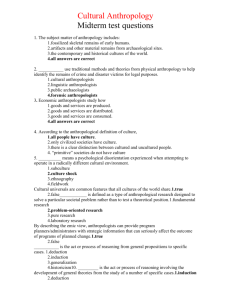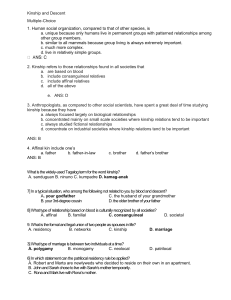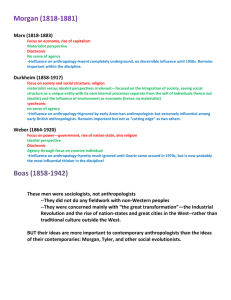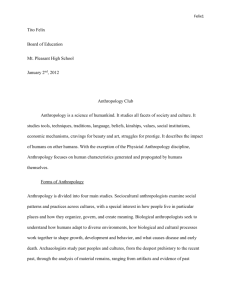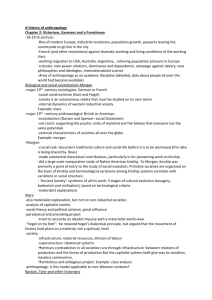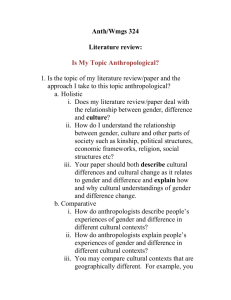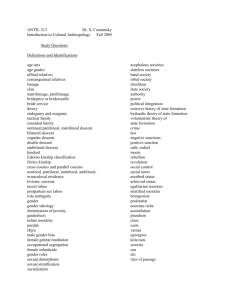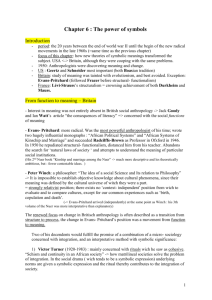Midterm test questions - International Institute of Anthropology
advertisement
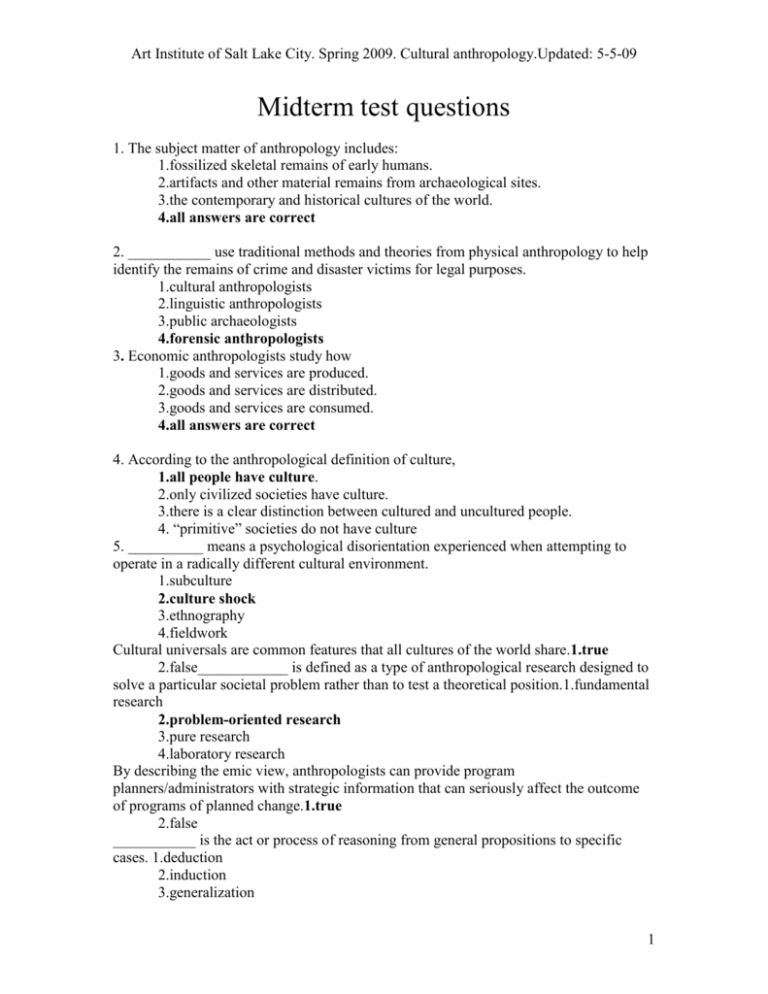
Art Institute of Salt Lake City. Spring 2009. Cultural anthropology.Updated: 5-5-09 Midterm test questions 1. The subject matter of anthropology includes: 1.fossilized skeletal remains of early humans. 2.artifacts and other material remains from archaeological sites. 3.the contemporary and historical cultures of the world. 4.all answers are correct 2. ___________ use traditional methods and theories from physical anthropology to help identify the remains of crime and disaster victims for legal purposes. 1.cultural anthropologists 2.linguistic anthropologists 3.public archaeologists 4.forensic anthropologists 3. Economic anthropologists study how 1.goods and services are produced. 2.goods and services are distributed. 3.goods and services are consumed. 4.all answers are correct 4. According to the anthropological definition of culture, 1.all people have culture. 2.only civilized societies have culture. 3.there is a clear distinction between cultured and uncultured people. 4. “primitive” societies do not have culture 5. __________ means a psychological disorientation experienced when attempting to operate in a radically different cultural environment. 1.subculture 2.culture shock 3.ethnography 4.fieldwork Cultural universals are common features that all cultures of the world share.1.true 2.false____________ is defined as a type of anthropological research designed to solve a particular societal problem rather than to test a theoretical position.1.fundamental research 2.problem-oriented research 3.pure research 4.laboratory research By describing the emic view, anthropologists can provide program planners/administrators with strategic information that can seriously affect the outcome of programs of planned change.1.true 2.false ___________ is the act or process of reasoning from general propositions to specific cases. 1.deduction 2.induction 3.generalization 1 Art Institute of Salt Lake City. Spring 2009. Cultural anthropology.Updated: 5-5-09 4.historicism10. _________ is the act or process of reasoning involving the development of general theories from the study of a number of specific cases.1.induction 2.deduction 3.evolutionism 4.neoevolutionism The kula ring, a system of trade found among the Trobriand Islanders, performs many functions including the function of distributing goods within the society.1.true 2.false Participant-observation allows ethnographers:1.to distinguish between normative and real behavior. 2.to gain a more accurate picture of the culture. 3.to study another culture from a culturally relativistic perspective. 4.all answers are correct Culture shock manifests itself in a number of symptoms, including a sense of:1.confidence and ethnocentrism. 2.confusion and being rejected. 3.having total control over the situation. 4.boosting of self esteem.Language:1.is found in all cultures. 2.is a symbolic system of sounds. 3.conveys meaning to its speakers. 4.all answers are correct In a/an_________________ the user can create new sounds or words by combining two or more existing sounds or word.1.closed system of communication 2.open system of communication 3.universal grammar 4.nonverbal system communication_________ involves the study of a language’s sound system.1.semantics 2.phonology 3.morphemes 4.dDiglossia The minimal linguistic forms that convey meaning are called ___________. 1.phonemes 2.morphemes 3.words 4.grammarsAn archaeological research in southern Peru suggests that in order to build an ideal agricultural system, Incas used:1.irrigation canals. 2.terracing. 3.tree planting. 4.all answers are correctMany horticulturalists supplement their simple cultivation with other food gathering strategies.1.true 2.false Transhumance and nomadism are two types of:1.food collecting techniques. 2.horticultural strategies. 3.movement patterns observed among pastoralist societies. 4.agricultural strategies.The intensification of agriculture and the rise of civilization led to the development of ___________. 1.food-gathering 2.nomadism 2 Art Institute of Salt Lake City. Spring 2009. Cultural anthropology.Updated: 5-5-09 3.peasantry 4.transhumance Inupiaq hunters of Alaska possess knowledge based on generations of systematic observations. 1.true 2.false It is possible to examine economic systems cross-culturally along the following key dimension(s):1.regulation of resources 2.production 3.exchange 4.all answers are correct Production is a systematic and organized process. 1.true 2.false__________ is the basic unit of production in most non-industrialized societies.1.household 2.individual 3.community 4.governmentThe prohibition against sexual relations with certain categories of kin is called 1. monogamy. 2. cross-cousin marriage. 3. the incest taboo. 4. endogamy. 27. A nuclear family includes all of the following EXCEPT 1. mother. 2. uncle. 3. father. 4. sister. Polyandry is 1. a man having more than one wife at a time. 2. a woman having more than one husband at a time. 3. a practice that keeps family land intact when there is a land shortage. 4. b and c only The decline in the percentage of nuclear families in the United States has been influenced by 1. the acceptance of alternative lifestyles in recent years. 2. the increasing divorce rate. 3. delays in childbearing and marriage. 4. all of the above 30. Kinship refers to those relationships found in all societies that 1. are based on blood. 2. include consanguineal relatives. 3. include affinal relatives. 4. all of the above. A kinship diagram of a married couple, their children, and their children’s children would 3 Art Institute of Salt Lake City. Spring 2009. Cultural anthropology.Updated: 5-5-09 include 1. four generations; therefore four rows of kinship figures. 2. three generations; therefore three rows of kinship figures. 3. only affinal relatives. 4. only consanguineal relatives. 32. A kinship diagram of a son, father, grandfather, and great grandfather would include 1. affinal relatives. 2. collateral relatives. 3. two genders. 4. lineal relatives. The most egalitarian societies (in terms of gender) are 1. industrialized. 2. horticultural. 3. pastoralist. 4. food collectors. Pregnant women in developing countries 1. face malnutrition. 2. face a lack of trained medical personnel to deal with high-risk pregnancies. 3. are 80 to 600 times more likely to die of complications of pregnancy than women in the industrialized world. 4. all of the above Dowry deaths are found in which part of the world? 1. India 2. Mexico 3. China 4. Kenya 36. Which two terms are synonymous (mean the same as) with shifting cultivation? [p. 157] 1. slash and burn farming and pastoralism 2. swidden cultivation and horticulture 3. slash and burn farming and swidden cultivation 4. swidden cultivation and horticulture 4
